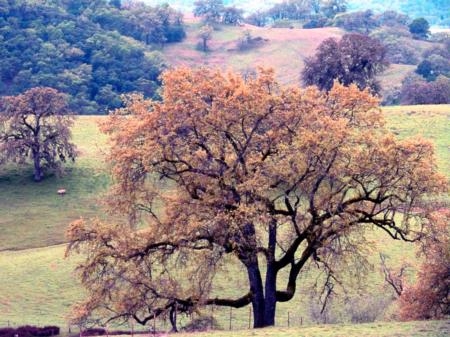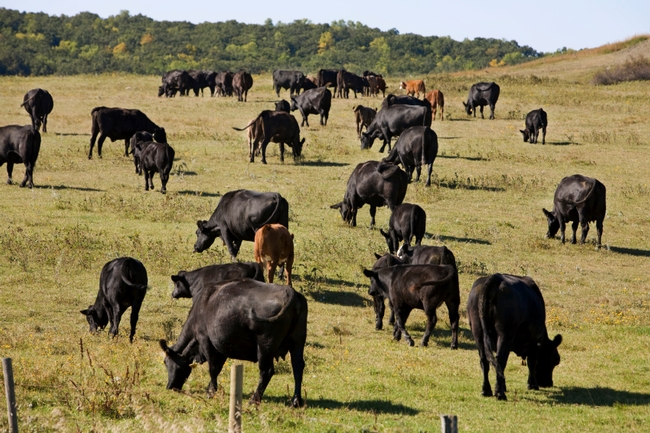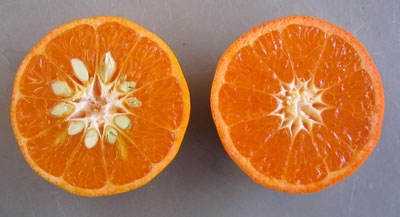Posts Tagged: Glenn Nader
It's raining in California, but drought concerns haven't been quenched
A storm is dropping some much-needed moisture in California today, but the drought drags on. Using UC sources, the media has been reporting on the effect of a prolonged rainless period this winter and well-below-average rainfall the last three years.
A story in the Los Angeles Times this week opened with the concerns of cattle ranchers. Without winter rain rangeland grass doesn't grow. Ranchers must decide whether to buy expensive feed or cull their herds to weather the drought.
"Their struggle is a bellwether for California's $45 billion agriculture sector," wrote reporter David Pierson. The repercussions will be felt beyond the state's borders. "The Golden State produces nearly half of all U.S.-grown fruits, nuts and vegetables and is the nation's leading dairy and wine producer."
Pierson quoted Doug Parker, director of the UC California Institute for Water Resources, in his article.
"The agriculture industry is definitely hit the hardest by drought," Parker said. "In California, agriculture uses 80 percent of water in the state. It's a major input for their business and hits their finances and employment directly."
The San Luis Obispo Tribune reported on drought hardships for SLO County fruit and vegetable farmers. Growers are facing increasing irrigation costs and taking steps to reduce salt buildup in the soil.
"The drought forces growers to prioritize crop cycles,” said Mary Bianchi, UC Cooperative Extension adviser. “What do you plant, and what do you leave fallow?”
In Stanislaus County, ranchers are expressing concerns about a trend among farmers toward planting almonds, reported the The Modesto Bee. Ranchers are worried the spread of almonds, walnuts an other high-value crops could strain their limited groundwater, drive up land prices and intrude on their way of life.
“It's not hard to understand why (farmers are planting more almonds),” said Roger Duncan, UCCE advisor. “It's very profitable.”
It was Duncan who provided the rough figures on almond profitability during the first day of the ninth annual summit of the California rangeland Conservation Coalition recently, wrote Bee reporter John Holland. Duncan said the net is even better for walnuts, which are not as extensive but still have had major growth in acreage. He also said the nut boom could be limited by a shortage of water and land.
The Drovers Cattle Network reported that cattle ranchers are seeking strategies for surviving the drought.
According to the article, rancher Billy McDonald's wife, Aileen, said she learned from UC Cooperative Extension farm advisor Glenn Nader that "you need to set a date, like if it doesn't rain by a certain date, to start culling. That's really important."
Also as part of the story, Roger Ingram, UCCE advisor in Placer and Nevada counties, advised ranchers to develop a drought plan.
Ingram warned against overgrazing and emphasized the importance of leaving enough residual dry matter in the ground to enhance seed germination and minimize soil erosion. With more bare ground, water would run off instead of soaking in, he said, and there would be less organic matter to feed soil microbes, resulting in fields being overrun by undesirable plants such as medusahead and yellow starthistle.
"Your grazing strategy should be take half, leave half," he said.
For those who are on irrigated pasture with limited water supply, UCCE advisor Larry Forero said fields are the driest in the summer but can get by with less water in the fall, so irrigate as close to evapotranspiration as possible and then stop irrigating. He also advised leaving four to five inches of stubble to facilitate pasture growth in the fall, should it rain or irrigation water become available.
UC to help ranchers survive winter 2013-14
The first agricultural operations to feel the impact of a drought are dryland ranchers, many of whom rely almost entirely on annual rainfall to grow food for their livestock. The UC Division of Agriculture and Natural Resources will hold a drought workshop from 9 a.m. to 3:30 p.m. Jan. 29 in Browns Valley to help these ranchers live on to fight another day, said Glenn Nader, UC Cooperative Extension advisor in Sutter-Yuba Counties.
"From previous droughts we've learned that feeding the whole herd through the drought may spell the end of business," Nader said. "We plan to provide information on management options and impacts of drought on dryland range and irrigated pasture, feeding options to consider during a drought and how to decide what cows to sell."
Nader is organizing the workshop, "Mitigating Drought - Optimizing Pasture and Supplemental Feed, and Managing Risk," with Jeremy James, director of the UC Sierra Foothill Research and Extension Center.
The workshop is designed to provide ranchers with information to manage their herds during a period of low feed supply. Practical tools and strategies to be presented include:
- Getting the most effective use out of limited dryland and irrigated pasture
- Alternative protein and roughage supplementation
- Understanding the economics of supplementation
- Managing animal health
- Making culling decisions
- Tax and insurance issues related to drought
The meeting will be at the UC Sierra Foothill Research and Extension Center, 8279 Scott Forbes Rd., Browns Valley, CA 95918. The complete agenda is posted online. Registration is $10 and includes lunch. To register, fill in this online form.
The forum will also be webcast for those that cannot attend in person. Register using the same online form.
Seven locations in the state will host meetings with the drought meeting webcast:
| City | Location | Contact |
| Hopland | Research and Extension Center 4070 University Road |
John Harper, (707) 463-4495 |
| San Luis Obispo | UC Cooperative Extension Auditorium 2156 Sierra Way |
Royce Larson, (805) 434-4106 |
| Livermore | NRCS office 3585 Greenville Road, Suite 2 |
Alyson Aquino, (925) 371-0154 x116 |
| Ventura | Ventura Farm Bureau 5156 McGrath St |
Fletcher Nelson, (661) 945-2604 x111 |
| Bakersfield | UC Cooperative Extension office 1031 South Mount Vernon Ave. |
Julie Finzel, (661) 868-6219 |
| Tulare | Veterinary Medicine Teaching and Research Center 18830 Road 112 |
Jim Sullins, (559) 684-3309 |
| Mariposa | UCCE Mariposa County Office -Ag Complex 5009 Fairgrounds Road |
Fadzayi Mashiri. (209) 966-2417 |
Foothill ranchers' hopes for a wet autumn were dashed in 2013
When spring 2013 passed without a healthy rainy season, ranchers pinned their hopes on good growth in the fall. However rain came late, leaving pastures to wait for warm weather to get grasses growing again, reported Ching Lee in the Sierra Sun Times.
"Things may germinate, but they'll just sit there," said Glenn Nader, UC Cooperative Extension advisor for Yuba, Sutter and Butte counties. "There's not going to be any rapid growth until March — unless we get an unusually warm December."
The state needs successive rain storms this winter to fill the ground with enough moisture to support decent growth next year, Nader said.
In the meantime, ranchers will have to purchase feed, but prices are higher because the drought also pushed down production.
"People can quickly feed themselves into a negative cash flow with today's hay prices," Nader said. "That's why a lot of people are looking at alternative dry matter sources such as corn stover, rice straw and other things, to try and cheapen up those costs."
UC's Tango mandarin touted in Smithsonian
UC Riverside research that resulted in the new, seedless mandarin variety Tango was featured in a Smithsonian magazine article written by Sarah C. Rich.
The story recounts how plant geneticist Mikeal Roose used irradiation on W. Murcott budwood to induce mutations that improve the fruit.
“Farmers have long selected citrus varieties that are low-seed, that have the same kinds of chromosomal rearrangements stimulated by the same thing—there’s natural radiation around all the time and it can affect the trees at any time.”
The advantage of inducing mutations, Roose explained, rather than waiting for the sun to trigger genetic variation, is that it can be targeted toward manipulating one particular feature—a kind of rapid prototyping for agriculture. The radiation accelerates the output of new genetic compositions. Each is then cultivated, screened and tested with the hope that at least one offspring will be reliably superior to its antecedent.
'Doom the Broom' demo is scheduled Thursday in Paradise
Chico Enterprise-Record
A live fire demonstration will help illustrate the need to clear growth from around structures and to be aware of the growth of Scotch, Spanish and French broom Thursday in the parking lot at 5400 Clark Road, Paradise, Calif. Glenn Nader, UC Cooperative Extension advisor for Sutter-Yuba counties, an expert in livestock and natural resources, will talk about spraying herbicides to control the weeds.
The event will go from 10:30-11:45 a.m., rain or shine. The fire demonstration will be at 11:05 a.m.
Grass-fed beef fights cancer, study finds
Several studies suggest that eating grass-fed beef elevates precursors for Vitamin A and E, as well as cancer-fighting antioxidants such as glutathione and superoxide dismutase, compared with eating beef from grain-fed animals, says a research review published in the current issue of Nutrition Journal.
The review, written by three Chico State professors and UC Cooperative Extension livestock advisors Glenn Nader and Stephanie Larson, reported that grass-fed beef has an overall lower fat content.
"However, consumers should be aware that the differences in (fatty acid) content will also give grass-fed beef a distinct grass flavor and unique cooking qualities," the researchers wrote.
In addition, the fat from grass-finished beef may have a yellowish appearance from the elevated carotenoid content (precursor to Vitamin A).
The research prompted San Francisco Examiner blogger Joshua Horrocks to ponder whether grass-fed beef is the key to cancer prevention. He noted that, in addition to grass-fed beef's higher levels of antioxidants, it has lower concentrations of monounsaturated fatty acids. MUFAs have been linked to a higher mortality rate for women.
The researchers have developed a Grass-Fed Beef Web page with information on the product's health benefits, niche marketing, labeling, cost of production and more.

The Grass-Fed Beef Web site.





